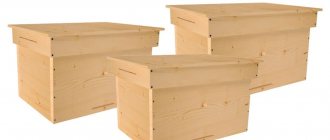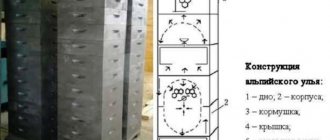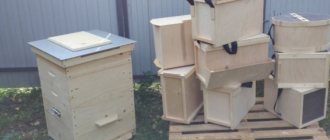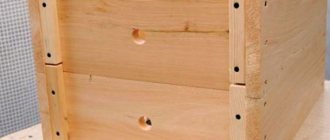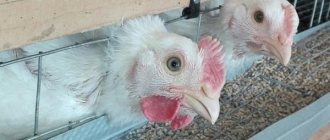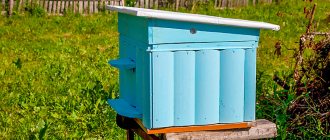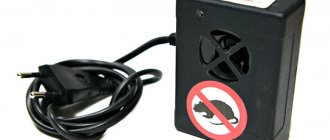Beekeeping is not only a common activity in our area, but also a favorite hobby for many connoisseurs of sweet and natural honey. In our regions, nature is rich in aromatic herbs, field and cultivated plants, which make it possible to collect not only the healthiest, but also the most aromatic honey with many medicinal properties. For a novice beekeeper, there is a huge assortment of hives, and everyone is convinced that his version of a bee house will allow him to collect a large amount of fragrant honey. But how to choose a hive for beekeeping: with horizontal or vertical risers, which design to give preference to, and what type of hive should a novice beekeeper pay attention to?
How does a hive work?
The hive structure includes bodies, frames with honeycombs, bottom, walls and other elements. The bottom can be solid or removable. The bottom panel is constructed from boards with a thickness of 25 mm. The space between them is filled with special insulating material. At the back, directly above the bottom level, there is a hole, the size of which must match the mesh subframe that is used to combat ticks.
Excessive demands are placed on beehives:
- Durability;
- Protection of bees from any negative influences from the external environment (cold, rain, wind);
- The ability to quickly and easily change the internal space of the hive;
- Suitability for wandering;
- Comfortable work of the beekeeper;
- Possibility of replacing any structural elements;
- Easy to assemble and affordable to purchase.
Which hive should you choose?
Hives for the beginning beekeeper
If this is your first experience, then it is best to choose a single-frame 12-frame hive. It is used together with two mentors, where 12 half-frames can be installed. From them you will receive honey, which can be used for personal needs or sold. All honey reserves that remain in the nest are intended for the wintering of bees and belong exclusively to them.
Hives for the experienced beekeeper
For professionals, the ideal choice is multi-hull hives, which provide maximum productivity. They allow you to carry out the maximum number of operations to reduce and expand nests, collect honey, and much more. This is not only comfortable, but also coincides with the natural habitat of bees. In this case, there is no need to interfere with the brood part of the nest, where the queen bee is usually located. Thus, when carrying out any work, you will not have to take your family out of work for a long time.
Seasonal work
The normal lifestyle of insects in an apiary requires constant participation and control from the beekeeper. Care does not stop either in winter or in summer. Here are the methods and seasonal work experienced beekeepers use:
- In early spring, check the bottom. This way you can control the temperature and how well the family is developing.
- Inspect the settlement for the presence of parasites. If, for example, varroa mites or any other mites are found, then measures must be taken to destroy them.
- If the hive is clean, then preventive antiparasitic measures are carried out.
- To help expand and strengthen the insect family, it is necessary to rearrange the internal sections and frames.
- In the summer, during intensive honey harvesting, you will have to add an additional section, building the house in height. This is to provide additional frames for the bees to fill with honey.
- If this is not done, then the opportunity to collect a larger number of different types of apiproducts will be missed. And the chances for a full supply of honey for the bee colony for the winter are reduced. This manipulation will allow for complete pumping of honey.
- When the last harvest is carried out, this usually happens no later than mid-August, the depleted combs can be placed in the upper part of the nest. Here they are aged until approximately September. After this, they will need to be stored in a suitable room.
Types of hives: 5 common modifications
To figure out which hive is best to choose, you must first find out by what criteria they differ and what types they are divided into. There are 5 modifications of hives:
- Sun lounger. The most common option for a novice beekeeper, it is a long body with a solid flat bottom. Capable of holding up to 36 nesting frames (435 x 300), additionally has magazine extensions, the number of which is proportional to the number of frames. During operation, it is permissible to divide the space for layering. The lounger is convenient for inspection and adding frames. A significant drawback is the heavy weight, difficulty in transporting and moving to a place for wintering. Anti-tick nets are installed quite rarely;
- Book. The honeycombs are arranged transversely, so you can place one hive on top of another. The location of the frames allows you to take them out at any time. Since there is no need to lift the honey body, the beekeeper can cope with this task independently;
- Double-hulled. Holds 12 frames (435 x 300), removable bottom, wall thickness - 40 mm, there is a metal mesh to resist ticks. Beekeepers equip the hive with two store extensions (435 x 145) under the frame. This hive has a complex design and is therefore recommended for professional and experienced beekeepers;
- Multihull. It has a removable bottom of 4 housings, each of which can accommodate 10 frames (435 x 230). It has a complex design and the thickness of all walls is at least 35 mm. Widely used by beekeepers in all regions of the country. Disadvantage: heavy weight and difficulty in inspecting honeycombs and rearranging housings;
- Retractable. It consists of honeycombs that are located in a suspended transverse position on a frame. The honeycombs slide out together with the frame; it is possible to install hives in tiers (with top loading). The disadvantage is that when inspecting the hive, all the honeycombs of the whole body move, and due to the fairly strong bonding of the honeycombs by bees, it will be difficult to pull out the entire block.
According to their structure, all hives are divided into two types:
- vertical risers;
- horizontal sun loungers.
Vertical hives are used more to increase the bee colony vertically. To do this, the housing housings with frames are installed in a vertical position. At the same time, horizontal hives allow bee colonies to grow by installing nesting frames.
Beekeepers' Tips
It should be noted right away that Nizhegorodets beehives are more suitable for experienced specialists. It is better for novice beekeepers to gain experience on wooden hives, and after accumulating a certain amount of basic knowledge, switch to hives made of polyurethane foam. This is due to the fact that wooden hives do not require such close control over temperature and humidity; they are self-regulating systems: excess moisture formed inside the house is absorbed into the wood and does not cause excess moisture inside it.
However, if the decision to purchase Nizhny Novgorod is nevertheless made, then it is necessary to pay attention to a number of points regarding the correct use of models
If the hives will winter in a hive, then it is recommended to leave the bottom mesh open. To ensure feeding of insects in winter, it is necessary to install a “store” extension
This is especially important when overwintering hives in the field, when feed consumption caused by an open bottom increases significantly. By the way, wooden models equipped with a solid bottom do not need such measures, since there is no significant increase in feed consumption. During wintering, it is recommended to place Nizhegorodets hives on high stands
This is due to the freezing of condensate flowing from the mesh bottom of the house and the formation of an ice block under the hive. Experienced beekeepers advise switching to Nizhegorodets starting with one or two hives. And only after all the subtleties of operation have been mastered, transfer all the bees to polyurethane foam.
However, in fairness, it is worth noting that some experienced specialists are against the use of plastic in the apiary, explaining that insects should be in hives made of natural wood, and the proximity of honey and synthetic materials is unacceptable. Therefore, when choosing Nizhegorodets bee houses, you need to objectively weigh the pros and cons, soberly assessing your capabilities and professionalism.
To learn how to assemble Nizhegorodets hives for wintering, see the video below.
Choosing hives: TOP 4 popular options for beginners
There are a huge number of varieties of hives. Some models are created on the basis of a common option, for example, the book type. But the beekeeper himself, during operation, gave the classic version innovative modifications. If the goal of bee breeding is not only moral pleasure, but also the result, material validity, then it is important to pay attention not only to the type of hive, but also to its individual qualities.
Dadana-Blatta, Alpine, Tsebro, Dadan, Varre, Farrara, Lezhak or multi-body - these are not all the names and varieties of hives. But the unifying quality of all the above models is their purpose and effectiveness. Each area has its own individual characteristics, the amount of herbs, and in each individual case it is advisable to consider one or another version of the hive.
Some hive models are designed for professionals, while others can be used by novice beekeepers. The main task is to decide on the type of hive. Let's look at 4 of the most widely and frequently used hives for beginning amateur beekeepers.
Cassette
Many beekeepers are thinking about how to increase the productivity of the bee colony. It is known that bees need honey plants in sufficient quantities to make honey.
Therefore, beekeepers often move their hives to areas with flowering plants. Not every house can be easily transported, so special designs were created for this task.
In order not to disturb the bees during loading and unloading of the houses, special platforms on wheels were provided. The buildings placed vertically are called cassette hives.
Expanded polystyrene hive
The main secret of the popularity of such a hive among beginners is its low cost. The minimum amount of materials for production or the purchase of a ready-made hive allows you to start with a small apiary and, after mastering the basics, move on to more complex designs.
The advantages of such a hive are not only thermal insulation properties, but also a number of other characteristic differences:
- lightness of design even with multi-tiered arrangement of buildings;
- not subject to rotting. The formation of mold, fungi, the material is unsightly for bugs and moths;
- modifications of the internal device are easy to change.
The assembly process also does not take much time, and even a beginner in beekeeping can understand all the features. But it is worth noting several disadvantages, including an additional fixation system and the need to change parts every 3-4 years.
Important. Hives made of polyurethane foam (multi-level or two-level) should not be exposed to the sun, since such material is not resistant to direct sunlight. In addition to the fact that the hive may become deformed, the bees may choose a more practical place to live.
Impact on honey quality
Polyurethane foam itself is an environmentally friendly material. Therefore, it is safe not only for bee colonies, but also for humans, from the point of view of its possible effect on honey.
Numerous studies have shown that polyurethane foam does not emit any foreign chemical elements around itself that can pollute the air or beekeeping products.
But one main feature must be taken into account - low-quality polyurethane foam can emit a specific unpleasant odor. Bees, due to the fact that they are very sensitive to any odors, can react very negatively to such a design.
Therefore, before buying polyurethane foam hives, you need to carefully smell the inside of the products, as the smell accumulates there. If the human sense of smell detects the slightest odors, such products should be discarded. It is necessary to choose those that are truly made of high-quality material.
Also, honey itself and other bee products are prone to the accumulation of foreign odors. Therefore, even if the bees accept such a house, in the future the honey may acquire a subtle smell that is formed inside such a synthetic product.
The use of high-quality polyurethane blanks eliminates these negative aspects.
Wooden lounger
The horizontal area allows you to accommodate a large number of frames, and the possibility of preparing an additional portion of honey for the winter period gives the beekeeper the opportunity to pay more attention to other features: prevention of the formation of mites and moths. The classic wooden lounger consists of 20 frames and two compartments, which have one common lid and magazine.
The main advantage of this option is the long service life and ease of inspection of the nest. Due to the fact that all manipulations can be performed without touching individual cases, the evidence remains in one place for many years, the wear and tear of both parts and the case over 5-10 years (or even more) is insignificant.
Particular attention should be paid to the bottom of the hive. The bottom of a wooden lounger must consist of at least two bars. The flooring must be at least 40 millimeters thick. Such characteristics help extend the life of the entire hive and avoid the need for reconstruction.
Does PPU insulation affect the quality of honey?
Polyurethane foam has been known since the 60s of the last century. It is obtained by mixing two components of polyol and polyisocyanate. Each of them individually is harmful to the human body, but interacting with each other they form a new substance - polyurethane, which is safe and neutral in relation to health and food products. Let me give you an example from life: sodium in its pure form is an extremely dangerous material, and chlorine is a toxic gas that, if it gets into the lungs, causes burns to the lung tissue and suffocation. And the result of the interaction of sodium and chlorine is table salt, which we eat every day. In defense of harmlessness, I will add that polyurethane has long been used in medicine. Thus, studies on the implantation of polymers into the human body for plastic purposes have shown the applicability and harmlessness of polyurethane materials. And the use of polyurethane foam for insulating hives does not affect the quality of honey and the life of bees.
The components of the Himtrust company are certified by sanitary and epidemiological regulatory authorities, confirming their safety for living organisms.
Multi-body wooden hive
The classic multi-body wooden hive consists of 4 buildings, which can be added or removed, depending on need. Each case is designed for 10 frames (435 x 230), which have extended side bars of 37 mm. During inspection, they are easily separated, which makes it possible to dispense with additional separators in case of transportation. Such hives help to facilitate the work of the beekeeper and increase the amount of honey production.
To increase the amount of honey, you can additionally install a round, flat tap hole with a diameter of 150 by 10 mm on top of the front wall of the body. The lower taphole is installed in the bottom trim and has a height of approximately 20 mm. The length of such a cast can be equal to the width of the front wall. A special liner is inserted into the specified opening to reduce the tap hole.
Important. Experience shows that cases with frames on average of 230 mm are the most convenient. In the spring, for the development of families, compact nests can be created in multi-hull hives, which must be seeded with a queen over almost the entire area of the comb. With this design it will be easier for other bees to maintain the desired temperature. Additionally, it is important to take care of ventilation.
The nuances of making beehives from PPS yourself
Expanded polystyrene hives can be purchased ready-made. Such structures can be collapsible or monoblock and consist of a body, a separating grid, a feeder, a lid and a bottom (mesh or closed). The most popular options include the above-mentioned bed hives, Dadan hives with 6 and 10 frames. In addition, if you wish, you can make a homemade bee hive from polystyrene foam. This can be done quickly, although certain skills and knowledge will still be needed. You just need to prepare the tools and materials, and follow the step-by-step instructions exactly.
Varre
Varre's buildings are four walls knocked together. As a result, the four walls form a box with a height of 21 cm. On two opposite sides there are folds for placing 8 rulers. If it is necessary to maintain an even distance between the rulers, it is recommended to additionally stuff nails with cut heads into the folds and mark slots at the ends.
In most cases, the use of such a hive is recommended for beginner beekeepers. Since there is a significant drawback to this modification - a reduced amount of honey. Many apiaries have such hives, but only as an experiment. The most common option for those who want to master the art of beekeeping is the use of vertical wooden beds.
Did you like the article? Save so you don't lose!
Modern beekeeping is characterized by the use of bee houses of various designs. It's no wonder that newbies are scratching their heads over the question of which hive is best.
Only experienced beekeepers who have already mastered the basic techniques of keeping bees and have decided on their needs, capabilities, and preferences can make the final choice.
Where to start searching
The question of choosing a suitable bee house can be divided into two parts:
- which hive is best for bees;
- which hive to choose for a novice beekeeper.
Usually the answers are not the same!
For example, beekeepers are well aware that multi-hull structures ensure the natural development of bee colonies. For thousands of years, these insects lived in tree hollows - their house was vertical.
Accordingly, with the vertical installation of additional buildings, life in the hive comes closer to living in nature. The families here are strong, willingly participating in honey collection and bringing a lot of nectar.
But for beekeepers, this design is rather a minus. When filled with fresh honey, the weight of the body is 60 kilograms or more. One person cannot cope with such a load. You will have to resort to someone else's help or use a lift.
But a beginner does not always have like-minded people in his family, and not everyone succeeds in assembling a homemade lift with their own hands. The factory version costs money, which may also not be available (especially if the apiary is a weekend affair, that is, in essence, just another hobby).
Buy or make it yourself?
Residents of Russia who dream of beekeeping always face a difficult question. Where to start - buy ready-made hives or make them yourself? There is no clear answer. Decide on a solution to the problem.
Calculate the economic costs. If the goal is intra-family consumption, treating beloved relatives, then the purchase of tools, machines, lumber will cost a pretty penny and will significantly increase unjustified expenses.
Of course, we must not forget the time spent making bee hives with our own hands. Time also costs money.
If carpentry has already been established, there are certain capacities, think about it. You will need high-quality drawings of bee hives. Fitting requires the highest degree of craftsmanship.
That is why the vast majority tries to purchase factory-made hives. They undergo appropriate certification and are unified. Payback is quick. Quality is put at the forefront.
Construction of bee houses
Keeping honey bees in a frame hive, familiar to modern people, dates back to 1851.
This year, the famous beekeeper Langstroth designed the first frames adapted for hanging inside the hive. This engineering solution made it possible to remove the honeycombs without any problems - there was a small gap of 0.7-0.8 cm between the frames.
The principles of assembling a bee house using the Langstroth method underlie the design of any modern hive. In the same century, other beekeeping scientists invented a honey extractor (1865), artificial foundation (1857) and a method for attaching it.
Interesting fact: According to Russian tradition, the authorship of the first frame hive is attributed to Pyotr Prokopovich. Two more famous beekeepers are also vying for the championship. Among them are Jan Gerzhon and August von Berlepsch. Prokopovich proposed an innovative approach to constructing bee houses in 1814. However, almost 40 years later it was Langstroth who received a patent for a similar invention. Its design has become the most popular and widespread in the world.
Vertical house from Cebro
The two main types of bee hive designs are:
1. Vertical - that is, with the arrangement of nesting combs and half-frames of honey stores (extensions) in several tiers.
The main advantages of this content:
- ease of use - less time is spent servicing the bee colony than when using other designs;
- higher yield of commercial honey;
- easier to control swarming (carried out as the number of tiers increases);
- the brood is not steamed from the stuffiness in the summer.
2.Horizontal design means the sockets expand horizontally. New honeycomb frames are gradually being installed in the house.
- ease of inspection;
- behind a blank partition (diaphragm) you can hold a nucleus or a small layer;
- In case of abundant honey collection, stores for honey are installed on top.
Vertical houses
Vertical hives (popularly risers, verticals) are:
Multi-body – formed from 5-6 separate “floors” or from three buildings and three magazine extensions. There are 10 hundred frames in each section.
More information about the multi-hull system:
Double-hull – having two tiers or a body with two extensions. There are designs for 24 and 12 hundred frames.
Dadan-Blatt hives (popularly Dadan, Dadan hives) are similar in design to double-hull houses. The classic is a house consisting of one body with 12 hundred frames and a magazine extension with twelve half-frames. This is exactly what French-born beekeeper Charles Dadan developed. There are also designs for 10 hundred frames. Instead of one magazine, they can be equipped with a full-fledged body or 2-3 extensions.
Tsebro hives , consisting of a nest with two additional buildings for 10 cells, and two buildings for 5 cells. The nest holds 14 frames.
Horizontal houses
Horizontal or single-hull hives (popularly known as bed hives) come in several types:
Ukrainian - standard houses for Ukrainian beekeepers, approved at the state level and accommodating 20 frames.
Houses with standard 24 frames are one of the most common designs.
Houses with rotated frames - that is, having honeycombs rotated 90 degrees to the standard position in the bed. The size of this frame is 300 by 453 millimeters.
Houses with 16 frames , consisting of one body and one or two magazine extensions with 16 half-frames. They are similar in design to risers assembled from two buildings with 24 or 12 nesting frames.
Keeping bees
In Roger Delon's hives, bee colonies develop faster, for example, the development of one building can occur in a week.
If you delay the installation of the second building, the bees will begin to swarm, since development will slow down. Therefore, you need to inspect the hives once a week, at least. Thus, such a simple design can provoke swarming. If this type of bee housing is chosen, then it is important for the beekeeper to master techniques to counter this phenomenon
Bees live in winter in only 2 buildings. In the spring, the bottom is replaced and the feed is checked and, if necessary, frames with beebread and honey are placed in the lower housing. The queen usually starts laying eggs in the upper housing because it is warmer there. Later, the queen will move down when all the combs are sown. The bodies should be swapped, and then the queen will continue to sow the upper one, and the lower one will be freed from sowing.
Number of frames and sizes
The number of frames in one hive, as can be seen from the description above, directly depends on the size of the bee hive, that is, on its design and configuration.
Below are the sizes of frames, half-frames and their quantity when the houses are fully equipped.
- external dimensions of each case – 496 mm (sidewall length), 445 mm (front and rear wall length), 250 mm (height);
- frame dimensions – 435 by 230;
- number of honeycombs - 10 pieces, total 50-60 frames (5-6 cases).
Double-frame (more often found on 12 hundred frames):
- external dimensions of the cases – 530 mm (length of the sides, front and rear walls), 370 mm (height);
- frame dimensions – 435 by 300;
- half-frame dimensions – 435 by 145;
- number of honeycombs - 12 or 24 nesting cells, 12 or 24 half-frames;
- number of honeycombs with two extensions - 12 or 24 nesting, 24 or 48 half-frames.
- external dimensions of the cases – 530 mm (length of the sides, front and back), 370 mm (height);
- frame dimensions – 435 by 300;
- half-frame dimensions – 435 by 145;
- number of honeycombs - 10 or 12 nesting honeycomb frames, 10-12 or 20-24, 30-36 half-frames; or two buildings for 20-24 nesting frames.
- body (base) – 640 by 722 mm;
- frame dimensions - 435 by 300;
- number of honeycombs - 14 nesting and 30 frames in extensions.
In the figure: 1 – nest, 2 – sections for 10 frames, 3 – sections for 5 frames.
- body dimensions – 830 length, 440 width, 600 mm height;
- dimensions of the standard frame – 435 by 300;
- number of honeycombs – 20 pieces.
For 24 hundred frames:
- external dimensions of the case – 870 length, 530 width;
- frame dimensions – 435 by 300;
- number of cells – 24.
For 16 hundred frames:
- internal dimensions of the case – 615 by 450 by 330 mm;
- frame dimensions – 435 by 300;
- half-frame dimensions – 435 by 145;
- number of honeycombs - 16 nesting, 16 or 32 half-frames.
Hive bottom
Let's start from the bottom of the hive. In a standard, classic hive-bed, the bottom is permanent. This is inconvenient, because... when carrying out an inspection and cleaning the bottom, you have to remove 5-6 frames from the hive. They need to be placed somewhere and returned to their place after cleaning. At the same time, the nest is rebuilt and cooled, and the bees become restless. In a word, it is very inconvenient.
A detachable bottom, like in multi-hull hives, helps to avoid this problem. During inspection, the body is simply removed and installed either on a spare bottom or on any flat surface (sheet of plywood, chipboard, etc.). As a result, you can safely clean the bottom and inspect the bee nest without disturbing the bees by rearranging the frames.
The bottom in this embodiment has a slope towards the front wall, which gives certain advantages:
- In case of rain, water does not enter the hive. In general, the hive remains dry in any weather.
- In addition, it is easier for bees to clean a hive with a sloping bottom from debris.
- Due to the fact that there is a slope, ventilation in such a hive is much better than in a classic hive.
Lower entrance barrier
It is also important that a lower wooden entrance barrier is installed at the bottom. In addition to the fact that it is convenient for them to adjust the size of the tap hole, the base of the barrier forms a kind of vestibule, preventing moisture from entering the tap hole. Metal barriers do not have this effect.
Hive body, diaphragms, roof liner, ceiling
The hive body is of standard sizes. The kit includes 2 diaphragms. For what? They allow you to adjust the size of the internal space of the hive depending on the number of bees and honey collection. Usually they start with 4 frames. As the bee colony develops, the diaphragms are moved apart, and frames are installed in the vacant space. The frames can also be placed behind the diaphragms, and then, when the bees “get used to” them, place them in the nest. During the winter, the nest shrinks. The diaphragms are also moved to the center of the nest, and insulation is installed between the walls of the hive and the diaphragms.
A ceiling is installed between the body and the roof liner. It separates the body from the liner and roof. Insulation is also placed on it. This helps maintain the microclimate in the nest. In addition, there is a 7mm gap between the frames in the hive and the ceiling. This allows the bees to move around easily within the hive. Installing canvas instead of a ceiling does not give this effect.
When inspecting the frames, one part of the ceiling is lifted, the frames are inspected, and the ceiling is returned to its place. The rest of the bees are not worried, which is important. At the same time, it is convenient to place a smoker on the closed ceiling (it is always at hand) and put the necessary tool. Moreover, it is not at all necessary to remove the liner. Moreover, with such an examination, the chance of losing the uterus is zero.
Langstron-Root hives
If you rummage through the historical layers, the founder of frame beekeeping is P.I. Prokopovich. It was he who led the revolution, abandoning the swarm method. His direction made it possible to offer a multi-body standardized hive.
Its creator, Langstron, was involved in its improvement. Then positive changes were made by the manufacturer, Ruth's compatriot.
The result was a good Langstron-Ruth combination, which instantly conquered the entire Western Hemisphere. It took almost 100 years for it to be popularized throughout the USSR.
The advantages of the Langstron-Root hive are as follows:
- The nest is more consistent with the natural vertical position. Working women willingly master interchangeable hive bodies
- Owners are impressed by the lightweight mass. It should be noted that in the USA they still maintain inch (25-26 mm) wall thickness. To avoid damage, each part is impregnated with paraffin. Amazing weather resistance! The warranty period is at least 50 years. We have different parameters for the thickness of the hive walls - 35-40 millimeters!
- Owning separating grids greatly facilitates the selection of sweet products. They do not allow queens to worm on a given land where pure honey is stored
- Operated by one person
- Picking is carried out in winter, autumn
- Labor costs are reduced. This makes it possible to have (in America, Canada) up to 1000 bee colonies at the same time. With our weak Russian mechanization, such a volume is difficult to imagine.
Drawing, photo:
A disadvantage for wintering is the reduced vertical of “only” 230 mm instead of 300 mm like the “Dadan”. When wintering in 2 buildings, the bee colony will have to cover an impressive distance when moving from the lower to the upper building.
Let's count: 22 is the top bar, 10 is the bottom bar, the same amount is the inter-frame space. Total – 42! Yes, plus there is still a gap to the honeycombs! If in January it stays at -20-25C degrees in the wild for a long time, the helpers are doomed to freeze from lack of food. Especially among weaker families.
Widely used “riser” hives with 3-4-5 bodies are often paired with reliable support. Their windage remains extraordinary, especially in the garden. Craftsmen are sometimes forced to drive in stakes and strengthen them with guy wires. Agree, the precaution is not unnecessary.
Magazine extension
When the colony has developed sufficiently, before the main honey harvest, a store extension is installed on the hive. At the same time, the roof with the roof liner and the ceiling are removed. The “magazine” is installed and the ceiling and liner with the roof are returned to their place.
A taphole was made in the store. In its absence, bees are very reluctant to go to the store. This is how standard stores are made. Store frames are filled with honey, and because... The queen practically does not rise to the store; there is no brood in it.
This option is designed for 16 frames and the same number of half-frames. Thus, the total number of complete frames is 24 pieces. Just like a hive with 24 frames or a hive with 2 bodies of 12 frames each.
Additionally, I would like to note that the number of frames in the case can be different, from 10 to 24 frames. But the principles stated above remain unchanged. It’s not without reason that they say that 50% of success depends on the hive and its quality. And the remaining 50% comes from the beekeeper himself, his care of the bees and, naturally, from the weather and honey collection.
General conclusion
To summarize, it can be noted that it is not entirely correct to compare a multi-body hive and a hive. Each house has obvious advantages and disadvantages. Everything will depend on the experience gained by the beekeeper in practice.
It is easier for a beginner to handle sunbeds. In them, the bee colony is always visible. There is no need to move heavy bodies and get confused in store extensions - the volume of the house is quite enough to obtain a decent honey harvest.
But if we are talking about migration, preference in any case is given to multi-hull structures. They are compact in size and allow you to handle large volumes of honey with repeated pumping (no need to disturb the nest every time). But at the same time, the content technology will be quite complex.
We emphasize once again that the main factors influencing the choice are:
Share a link to the article on social networks:
Source
